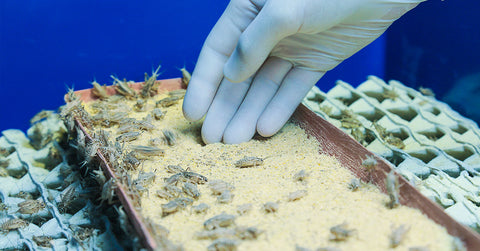Feed is one of the most interesting problems when raising crickets. Crickets can be fed a wide variety of different feeds including biowaste which makes them amazingly sustainable. Unfortunately, cricket farming is still in its infant years and nobody really knows what the perfect feed should be. Let’s take a look at what we feed crickets at our farm now and what is under development.
Testing out various feed formulations
Currently we use several different types of feed formulations. Their composition varies based on the age of the cricket. We use feed that’s very similar to chicken feed, containing a mix of grains and flours but we are also testing formulations that have a substantial proportion of biowaste.

Our goal is 100% biowaste feed
We know that crickets can convert feed into edible weight more efficiently than chickens (1). And we think it should be possible to have a feed made up of 100 % biowaste. It will just take our research and development team some time. Currently, we are testing agricultural waste streams like grains from breweries or fruit waste from juice producers.

Watering is important too
Crickets are very sensitive to everything they ingest. That’s why we have to focus not only on feed but water supply too. We have our own well fitted with a filtration system including ozone and several other filters to ensure the highest quality water. Our research team is also testing different materials that deliver the water to crickets. Crickets can’t drink from an open water source because they would drown. They have to get their hydration from sponge-like materials.

Support a sustainable startup with a big mission, try Sens products
At Sens, our mission is to make cricket protein look good and taste delicious! You can experience it with our tasty protein bars, gluten-free pasta, savoury protein crackers, baking cricket flour, or nutritious chocolate protein blend.
Sources:
1) Lundy ME, Parrella MP, ‘Crickets are not a free lunch: protein capture from scalable organic side-streams via high-density populations of Acheta domesticus.’, PLoS One. 2015, https://www.ncbi.nlm.nih.gov/pubmed/25875026




